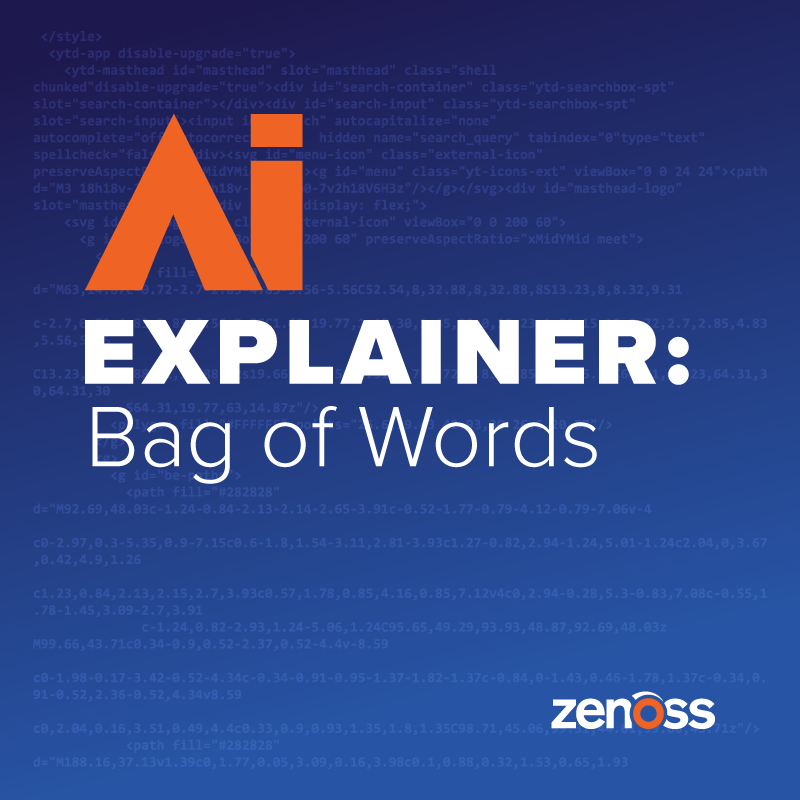In my last blog post on feature extraction, I mentioned something called the bag-of-words (BoW) technique. I decided to write a little bit more on that, mostly just because I think it’s a funny label for something so technical.
The BoW technique is a fundamental method used in natural language processing for representing text data in a numerical format that machine learning algorithms can understand. It is a simple yet powerful approach that converts text documents into vectors based on the frequency of words appearing in the documents, disregarding the order in which they appear. The term "bag of words" originates from the analogy of treating a document as a "bag" of words, where the order of words is ignored, and only their presence or absence is considered.
Here's how the BoW technique works:
- Tokenization: The first step is to tokenize the text documents, which involves breaking them down into individual words or tokens. Punctuation marks and special characters are typically removed, and words are converted to lowercase to ensure consistency.
- Vocabulary Construction: Next, a vocabulary is constructed by collecting all unique words (tokens) from the corpus of text documents. Each word in the vocabulary represents a unique feature in the vector space.
- Vectorization: Once the vocabulary is established, each document is represented as a numerical vector, with the length of the vector equal to the size of the vocabulary. The value of each element in the vector corresponds to the frequency of the corresponding word in the document. If a word is present multiple times in the document, its count will be higher in the vector.
- Sparse Representation: Since most documents contain only a small subset of the words present in the entire vocabulary, the resulting vectors are typically sparse, with many zero-valued elements. This sparse representation helps conserve memory and computational resources.
Below is a simplified example to illustrate the BoW technique.
Consider the following two text documents:
- Document 1: "The cat sat on the mat."
- Document 2: "The dog chased the cat."
After tokenization and vocabulary construction, we have the following vocabulary: the, cat, sat, on, mat, dog, chased.
Now, we represent each document as a numerical vector based on the frequency of words in the vocabulary:
- Document 1 Vector: [2, 1, 1, 1, 1, 0, 0].
- Document 2 Vector: [2, 1, 0, 0, 0, 1, 1].
In these vectors, each element corresponds to the count of the corresponding word in the document. For example, the first element represents the count of "the," the second element represents the count of "cat," and so on.
A basic real-world example of how the BoW technique can be applied to solve a problem is in sentiment analysis of customer reviews. Say a company wants to analyze customer reviews of its products to understand customer sentiment (positive, negative, or neutral) toward the products. Suppose that company has a dataset of customer reviews with corresponding sentiment labels. After preprocessing and vectorization using BoW, each review is represented as a numerical vector. For example:
- Review 1: "This product is amazing! I love it!"
- BoW Vector: [1, 0, 0, 0, 0, 1, 1] (assuming the vocabulary is: this, product, is, amazing, love, it).
- Review 2: "The product arrived damaged. Very disappointed."
- BoW Vector: [1, 0, 0, 0, 1, 0, 0].
The trained classifier can then use these BoW vectors to enable automated sentiment analysis, predicting sentiment labels for new customer reviews, and helping the company gain insights into customer opinions and improve its products or services accordingly.
The BoW technique has various applications in natural language processing, including sentiment analysis, text classification, document clustering and information retrieval. Despite its simplicity, it serves as a foundational method for representing text data and has paved the way for more advanced techniques in natural language processing.
If you want to see some of the cool things Zenoss is doing with AI, click here to schedule a demo.










